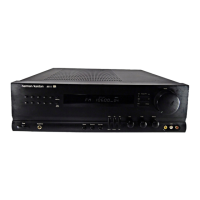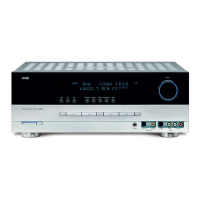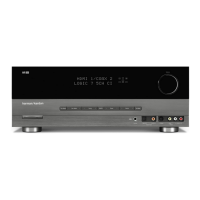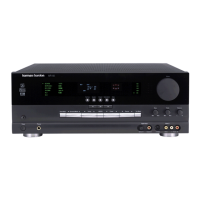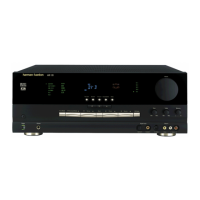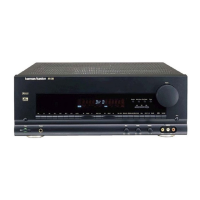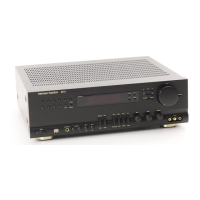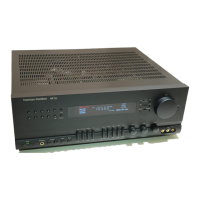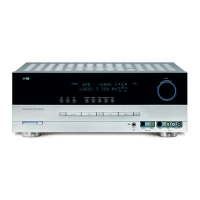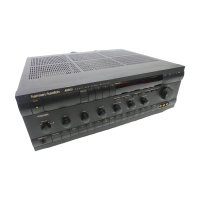Rear-Panel Connectors, continued
Radio Antenna connectors: Connect the included AM and FM antennas to their
respective terminals for radio reception.
Analog Audio Input/Output connectors: Use the AVR’s Analog Audio Input/Output
connectors for source devices that don’t have HDMI or digital audio connectors. Use the
Rec Out connectors to connect to the audio inputs of a VCR or tape deck. See Connect
Your Audio and Video Source Devices, on page 13, for more information.
Network connector: Use a Cat. 5 or Cat. 5E cable (not supplied) to connect the AVR’s
Network connector to your home network to enjoy Internet radio and content from DLNA-
compatible devices that are joined to the network. See Connect to Your Home Network,
on page 15, for more information.
Subwoofer connector: Connect this jack to a powered subwoofer with a line-level input.
See Connect Your Subwoofer, on page 13, for more information.
IR In and Trigger Out connectors: When the IR sensor on the front panel is blocked
(such as when the AVR is installed inside a cabinet), connect an optional IR receiver to the
IR In jack. The Trigger Out connector provides 12V DC whenever the AVR is on. Connect
it to the trigger input of a device such as a powered subwoofer.
Speaker connectors: Use two-conductor speaker wire to connect each set of terminals
to the correct speaker. See Connect Your Speakers, on page 13, for more information.
HDMI
®
Input connectors: The HDMI (High-Definition Multimedia Interface) feature is
a connection for transmitting digital audio and video signals between devices. If your
source devices have HDMI connectors, using them will provide the best possible video
and audio performance quality. Since the HDMI cable carries both digital video and digital
audio signals, you do not have to make any additional audio connections for devices you
connect via HDMI connections. See Connect Your Audio and Video Source Devices, on
page 13, for more information.
HDMI Monitor Out connector: If your TV has an HDMI connector and you have HDMI
source devices, use an HDMI cable (not included) to connect it to the AVR’s HDMI Monitor
Out connector.
Notes on using the HDMI Monitor Out connector:
s7HENCONNECTINGA$6)EQUIPPEDDISPLAYTOTHE($-)-ONITOR/UTCONNECTORUSE
an HDMI-to-DVI adapter and make a separate audio connection.
s-AKESURETHE($-)EQUIPPEDDISPLAYIS($#0COMPLIANT)FITISNTDONOTCONNECT
it via HDMI; use a composite analog video connection instead and make a separate
audio connection.
Composite Video Input connectors: Use composite video connectors for video source
devices that don’t have HDMI or component video connectors. You will also need to make
an audio connection from the source device to the AVR. See Connect Your Audio and Video
Source Devices, on page 13, for more information.
Composite Video Monitor Output connector: If your TV or video display does not have
an HDMI connector, or if your TV does have an HDMI connector but you are connecting
some source devices with only composite video connectors, use a composite video cable
(not included) to connect the AVR’s Composite Video Monitor Out connector to your TV’s
composite video input connector.
Digital Audio Input connectors: If your non-HDMI source devices have digital outputs,
connect them to the AVR’s digital audio connectors. NOTE: Make only one type of digital
connection (HDMI, optical or coaxial) from each device. See Connect Your Audio and Video
Source Devices, on page 13, for more information.
RS-232 connector: This connector is used to connect to external control hardware.
Consult a certified professional installer for more information.
Main Power switch: This mechanical switch turns the AVR’s power supply on or off. It is
usually left on and cannot be turned on or off using the remote control.
AC Input connector: After you have made all other connections, plug the supplied AC
power cord into this receptacle and into an unswitched wall outlet.
AVR1700 harman/kardon
9
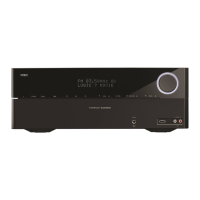
